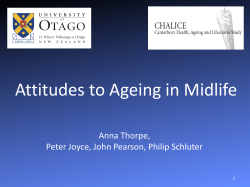
'Characterising the Healthy Ageing Phenotype'
Assessing nutritional status in older adults: Developing tools to measure healthy ageing Dr Jose Lara Institute of Cellular Medicine Newcastle University Workshop: “Examining diet and physical activity behaviours amongst older women through the lens of superdiversity” University of Birmingham September 18, 2014 Remit of LIVEWELL Programme The process of ageing is complex Langie, Lara, Mathers. Best Pract Res Clin Endocrinol Metab 2012 Prevalence of healthy ageing • • • USA Health and Retirement Study (1998-2004) of adults ≥65 yrs of age Survey of Health, Ageing, and Retirement in Europe (SHARE) of adults ≥65 yrs of age Criteria used: – – – – – No major disease (DM, Cancer, Lung disease, Heart disease or stroke) no activity of daily living disability no more than one difficulty with 7 measures of physical functioning ≥ median score cognition being actively engaged USA Health and Retirement study Survey of Health, Ageing, and Retirement in Europe (SHARE) Overall 11.9% Overall 8.5% Men 12.2% Denmark 21.1% Women 11.0% Sweden 17.4% Non-Hispanic white 12.2% Netherlands 17.0% Non-Hispanic Black 6.0% Switzerland 16.1% Hispanic 5.3% Ireland 15.7% Poland 1.6% McLaughlin et al. J Gerontol B Psychol Sci Soc Sci. 2010 Hank K. J Gerontol B Psychol Sci Soc Sci. 2011 Measuring change in intervention studies to promote healthy ageing Baseline measures of healthy ageing phenotype Intervention Behaviour change Functional benefit Outcome measures of healthy ageing phenotype Tools to measure healthy ageing phenotype ↑ pulmonary function predicts ↑ longevity Low High 906 people (mean age 81 y) without dementia Buchman AS et al. (2008) Mech. Ageing Dev. 129, 625-631 Physical capability predicts mortality Grip strength predicts mortality even in younger (<60) people Cooper R et al. (2010) BMJ 341, C4467 Tools to measure healthy ageing phenotype Characteristics: Robust Validated Comprehensive Appropriate for lifestage Capable of measuring difference in response to an intervention Cost effective Suitable for use in community settings Healthy Ageing Phenotype: How did we proceed? Aim • Identify Systematic Reviews and/or Meta-analysis of cohort studies • Identify Clinical guidelines (e.g. NICE- National Institute for Health and Clinical Excellence) Consideration for Selection criteria • Frequently used in longitudinal studies • Expected to change with age • Evidence for strong association/prediction of ageing-related phenotypes such as morbidity, mortality, lifespan • Focus on studies measuring these outcomes in healthy populations rather than on individuals selected on the basis of a particular disease • Biomarkers that respond to intervention Some markers of Physiological and metabolic function (Bio)marker Syst-Review/ meta-analysis Change with age Predicts ageing phenotypes Modified by intervention Blood Pressure +++++ +++++ BP arm difference +++++ +++++ Total Cholesterol ++++ +++++ HDL cholesterol ++++ +++++ LDL cholesterol ++++ +++++ Cholesterol ratios ++++ +++++ Triglycerides ++ +++++ Fasting glucose +++++ +++++ HbA1C +++++ +++++ 1-2 hr OGTT +++++ +++++ Metabolic Syndrome ++++ ++++ Coagulation Fibrinogen +++ +++ Inflammation CRP +++ +++ Lung function FEV1 ++++++ ++++++ Body composition BMI ++ ++++++ WC +++ ++++++ WHR +++ +++++ CV/Metabolic Workshop on The Healthy Ageing Phenotype Newcastle, UK held in October 2012 (i) (ii) Identify the most important features of the HAP Identify or developing tools for measurement of those features specifically in the context of community-based intervention studies. Healthy Ageing Phenotype (HAP) Lara et al., Maturitas 2013 Informative biomarkers of ageing in the Newcastle 85+ study Martin-Ruiz, et al., Mech Ageing Dev. 2011 Ageing studies with Biomarkers • • • • • • • • • • • • • • • China Health and Retirement Longitudinal Study (CHARLS) Chinese Longitudinal Healthy Longevity Survey (CLHLS) Costa Rican Longevity and Healthy Aging Study (CRELES) English Longitudinal Study of Ageing (ELSA) Health and Retirement Study (HRS) Indonesia Family Life Survey (IFLS) INDEPTH Network Los Angeles Family and Neighborhood Survey (LA FANS) Longitudinal Aging Study in India (LASI) Mid-Life in the U.S. Study (MIDUS) National Health and Nutrition Examination Survey (NHANES) National Health and Aging Trends Study (NHATS) National Longitudinal Study of Adolescent Health (Add Health) National Longitudinal Survey 1979 Cohort (NLSY79) National Social Life, Health and Aging Project (NSHAP) • • • • • Newcastle 85+ 74 BIOMARKERS Social Environment and Biomarkers of Aging Study (SEBAS) Survey of Health, Ageing and Retirement in Europe (SHARE) Tsimane Health and Life History Project Wisconsin Longitudinal Study (WLS) Conclusions • We propose five domains to characterise healthy ageing and tools to measure specific subdomains • Pilot study testing interventions and outcome measures to be completed December 2014 • Novel biomarkers validated in longitudinal studies of ageing could be incorporated as available LiveWell: ‘Where are we now’? • Pilot RTC to be completed December 2014 • Panel of outcome measures developed for each domain Acknowledgements 1 Investigators: John Mathers Thomas Meyer Paula Moynihan Lynn Rochester Falko Sniehotta Martin White Research team: Elizabeth Evans Alan Godfrey Ben Heaven Nicki Hobbs Alexandra Munro Shakir Chowdhury Caroline Wiuff Jose Lara PhD Students: Lynn Barron Caroline Shaw Suzanne McDonald Sanchia Coatsworth Collaborators: Ashley Adamson Vera Araujo-Soares Mike Catt Lynne Corner John Matthews Patrick Olivier Mike Trenell Thomas von Zglinicki Suzanne Moffatt Acknowledgements 2 Lara et al., BMC Med 2014 F&V intakes in 22 RCTs by the presence or absence of the “barrier identification/problem solving” BCT Lara et al., BMC Med 2014 (In Press) F&V intakes in 22 RCTs by the presence or absence of the “plan for social support/social change” BCT Lara et al., BMC Med 2014 (In Press) Table 2. Association of behaviour change techniques (BCTs) with Fruit and Vegetable intakes in 22 intervention studies BCT No. of studies or subgroups BCT present Yes (No) Sample size BCT present Yes (No) BCT present Mean difference (95% CI) I2 (95% CI) BCT absent Mean difference (95% CI) I2 (95% CI) Motivational interviewing 7 (18) 10183 (49503) 52.8 (33.1 to 72.8) 81 (61 to 90) 105.1 (71.4 to 138.7) 97 (95 to 97) Provide information on consequences of behaviour to the individual Prompt review of behavioural goals Goal setting (behaviour) 11 (14) 12488 (9394) 60.1 (45.0 to 75.3) 62 (27 to 80) 109.6 (64.6 to 154.9) 96 (95 to 97) 5 (20) 7163 (52562) 69.1 (55.8 to 82.3) 53 (0 to 83) 92.9 (59.7 to 126.1) 97 (96 to 98) 23 (2) 59323 (402) 89.0 (63.6 to 114.5) 97 (96 to 98) 95.7 (-63.1 to 254.4) 88 (N/A) Model/Demonstrate the behaviour Provide instruction on how to perform the behaviour Provide information on consequences of behaviour in general Provide feedback on performance Goal setting (outcome) 6 (19) 3258 (56467) 91.3 (56.9 to 125.7) 71 (32 to 87) 85.0 (55.9 to 114.2) 95 (97 to 98) 15 (10) 53717 (6008) 99.5 (69.6 to 129.5) 97 (96 to 98) 67.8 (34.5 to 101.2) 78 (59 to 88) 18 (7) 53298 (6427) 97.8 (67.6 to 127.9) 97 (96 to 98) 66.7 (32.3 to 101.1) 86 (74 to 93) 14 (11) 54563 (5162) 102.5 (68.9 to 136.0) 98 (97 to 98) 63 (37.9 to 88.0) 78 (60 to 87) 11 (14) 43702 (16023) 118.1 (74.3 to 161.9) 97 (96 to 98) 62.8 (43.5 to 82.2) 83 (73 to 90) 9 (16) 41627 (18098) 127.4 (74.1 to 180..7) 95 (92 to 97) 60.9 (43.4 to 78.4) 86 (78 to 91) Use of follow-up prompts Lara et al., BMC Med 2014 (In Press) (Mean difference of Mean differences (95%CI)) P (-52 (-91 to -13)) 0.009 (-49 (-97 to -2)) 0.040 (-24 (-60 to 12)) 0.190 (-7 (-166 to 153)) 0.940 (6 (-39 to 51)) 0.790 (32 (-13 to 77)) 0.170 (31 (-15 to 77)) 0.180 (39 (-2 to 81)) 0.060 (55 (7 to 103)) 0.020 (66 (10 to 123)) 0.020 Meta-regression of number of BCTs on overall F&V intake Number of BCTs. Slope = 8.28, Q = 3.84, d.f. = 1, P = 0.049. The circle size reflects the weight that a study obtained in the meta-regression. Lara et al., BMC Med 2014 (In Press) Table 2. Behaviour change techniques (BCTs) associated with intervention effectiveness Reference Outcome Lara et al 201438 Increasing fruit and vegetables among older adults Olander et al 2013 51 French et al 2014 52 BCTs associated with greater effectiveness of interventions “Barrier identification/problem solving” BCTs associated with lower effectiveness of interventions “Plan for social support/social change” “Goal setting (outcome)” “Use of follow-up prompts” Increasing physical activity in obese individuals “Teach to use prompts/cues” Increasing physical activity in obese individuals None “Prompt practice” “Prompt rewards contingent on effort or progress towards behaviour” “Setting behavioural goals” “Prompting self-monitoring of behaviour” “Planning for relapses” “Providing normative information” “Providing feedback on performance” Lara et al., Proc Nutr Soc 2014 (In Press) Gardner et al 2011 53 Hill et al 2013 54 Reduce gestational weight gain No obvious differences in the behaviour change techniques employed between effective and ineffective interventions Reduce gestational weight gain “Provision of information on the consequences of behaviour to the individual” “Motivational interviewing” “Behavioural self-monitoring” “Providing rewards contingent on successful behaviour” Hatmann-Boyce et al 2014 55 Promoting weight loss in adults “Provide information about others’ approval” “Provide normative information about others behaviour” “Model/demonstrate the behaviour” “Facilitate social comparison” Martin et al 2013 56 Preventing and managing childhood obesity “Provide information on the consequences of behaviour to the individual” “Environmental restructuring” “Prompt practice” “Prompt identification as role model/position advocate” “Stress management/emotional control training” “General communication skills training” “Prompting focus on past success” “Prompt self-talk” F&V intakes according to the presence or absence of the behaviour theories Lara et al., BMC Med 2014 (In Press) F&V intakes in 22 RCTs according to the presence of single vs multiple behaviour theories Lara et al., BMC Med 2014 (In Press)
© Copyright 2025















